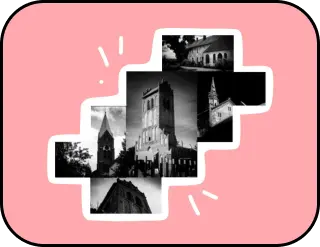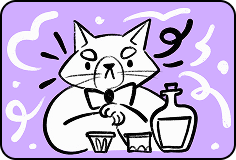Ode to Quantum Paradoxes
Disclaimer. The editors of The Global Technology magazine insist that this article is for educational purposes only. We deeply admire all the scientists whose names and discoveries were featured in the article.
This episode could well have happened in one of the parallel Universes, and it might not have happened. Quantum physics does not deny this, and does not claim the opposite either.
– Gentlemen, deadlines are running out, customers are nervous,’ a short man quickly entered the room. You could see a piece of a drawing ruler from the pocket of his gray rumpled jacket, and a badge with the name Einstein on his back. ‘I remind you that we are making a film that will show that all our knowledge about familiar things is not really knowledge, because everything that exists in the world is relative. I hope you brought all the scripts?
He looked around the room in which the greatest scientists of the 19th and 20th centuries had gathered and stopped his gaze on a puny man in a long black cloak and glasses:
– Let’s start with you, Mr. Schrödinger.
A figure in a black cloak, holding a cat, separated from the group of scientists, modestly shifting from foot to foot, and walked decisively towards the demonstration table. The lapels of the cloak, similar to the tentacles of a giant octopus, obediently followed the figure along the floor, adding incredible magical mystery to his image.
– What did you bring to us, Mr. Schrödinger?
The scientist walked up to the table, silently placed a box from nowhere on it, and silently put the cat in it.
– Mr. Schrödinger, what is this?
– A Cat,’ the scientist finally said. A Cat in a box.
– Well, at least it’s not in a bag, Einstein smiled and looked at Mr. Schrödinger, whose face did not move a single muscle. ‘And how will your Cat change our picture of the world?
– It will be both alive and dead at the same time, answered Mr. Schrödinger.
The scientists standing on the side began to whisper. A roar arose in the hall, and the cat, which did not know that it was the key figure in the experimental film, jumped out of the box and began to run. Mr. Schrödinger blocked its way and calmly continued:
– Scene number one. A close-up shot of a box that should be closed. The second hand of the clock slowly taps the rhythm, and a metallic voice-over informs the audience that an ordinary cat is sitting in a closed box and next to it there is a device that can take this cat’s life at any moment if the decay process of just one uranium atom is triggered in the device. At this point, you can increase the music and say that the process of atomic decay is absolutely random and it may or may not happen. That is, the cat can potentially either die or survive.
After these words, Mr. Schrödinger waved his hand, imitating the gesture of a wizard:
– Ta-ta-ta-taaa! Scene number two. Again there is a ticking clock and a voice-over that warns that the box must not be opened under any circumstances. Even in my fantasies. Even for an impressive sum of money. Never. Because while the box is closed, the cat for each viewer is in two states at once, it is both alive and dead at the same time. Here again the camera hits the box and the inscription “So who will kill the cat?” appears right on the box.
At this point, Schrödinger drew a ticker in the air.
There was silence in the hall, which was occasionally interrupted by the question, ‘What the…’
To interrupt the silence, Schrödinger continued:
– While viewers look at the box, various processes take place in it. First, the atom becomes entangled with the nucleus, then the nucleus itself somehow becomes entangled with the device, then the device becomes entangled with an ampoule of poison, then the ampoule somehow becomes entangled with a cat, and all these entanglements lead to a certain scenario at the end. The cat will be either alive or dead.
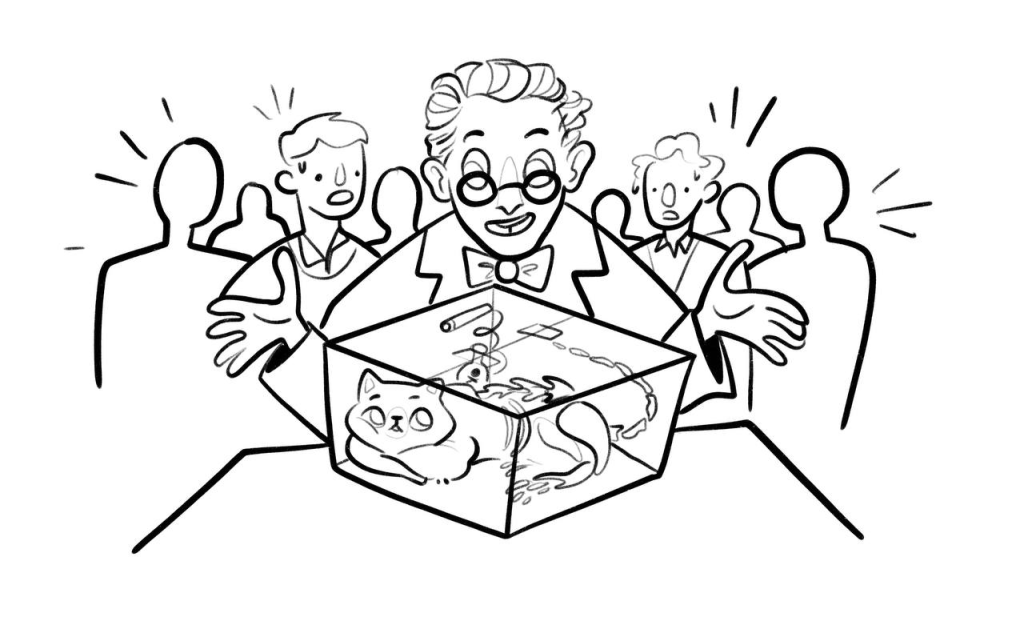
Einstein, noticing that the scientists were becoming nervous, decided to intervene:
– Schrödinger, you, of course, have a very unusual scenario in which nothing is clear – the cat is either alive or dead, the process of atomic decay may or may not happen. Are you asking the viewer to just sit and watch this?
– The essence of my scenario is that there is no need to watch the box,’ Schrödinger said in a conspiratorial tone. ‘As I’ve already said, processes are taking place in the box, and if “observers” intervene in them, the core, cat, and ampoule will have to get confused with them too. And this can lead to completely different results, and then the cat that was alive will definitely be dead.
Einstein exhaled tiredly, wiped the sweat from his forehead and took off his glasses:
– Schrödinger…and on this uncertainty – “either, or’”, are you going to build fundamental science?
– You’re wrong, Mr. Einstein, we know what state the cat is in, but we don’t know who will end up being God,’ Schrödinger answered confidently. ‘The end of this film depends on who will be in the “superposition”. First, the nucleus is in superposition with respect to the cat, because it is simultaneously in all states; either the decay process will occur in it or not. And then, if a viewer decides to open the box, the viewer will be God. An uncertain ending.’ Schrödinger extended his palms forward, ‘A red pill or a blue one?
Einstein stood up from his seat, opened the box in which a completely intact cat was sitting, took it in his arms and solemnly said:
– Damn it, Schrödinger, it’s nice to be God! It’s nice to be God!
He lowered the cat to the floor and began to pace the room, as if desperately trying to understand something. The cat followed him silently. Having made another circle around the room with his four-legged companion, Einstein again addressed the audience:
– Gentlemen scientists, do you have any other equally exciting scenarios in which, this time, everyone will remain alive?
A figure dressed in a 19th-century tailcoat emerged from the crowd of scientists and quickly walked towards the demonstration table:
– I do! I do! In my scenario, everyone is alive and everyone is dancing. Turn off the lights.
After the light in the hall was turned off, the scientist, whose name was Thomas Jung, placed 2 metal plates on the table, each of which had 2 slits that let light through. Thomas Young took a flashlight from his pocket and directed a beam of light at these plates.
– Here, can you see? he asked the audience.
– What must we see, Mister Jung? Einstein asked.
– You must see how the beam passes through 2 slits, leaving 2 strips of light on the free wall, the scientist answered him, waving a lantern.
– We can see this, Einstein answered him and looked at the floor where the cat was sitting. The cat, as a sign of agreement with the professor, took a comfortable position and began to loudly lick its paw.
– But how will what we see make us and potential viewers doubt the correctness of our judgment?’
Mr. Jung turned off the flashlight and began to whisper, ‘Now let’s not look at the wall, on which the pattern from the rays of light must appear. Let’s look, for example, to the left and with the help of lateral vision we will see whether the pattern on the wall has changed. Turn off the lights.’
As soon as the lights in the room were turned off, Thomas Jung again took out the flashlight and directed a beam of light at 2 slits on the metal plate.
– Everyone, look to the left!’ he commanded.
The audience, Professor Einstein, and even the cat turned their heads to the left. Out of their peripheral vision they saw that the pattern on the wall had changed. There were no longer 2 slender vertical stripes, there was an interesting pattern consisting of many dots that were constantly moving. It really looked like a dance.
– And now, everybody, look at the wall again!’ Yung shouted. After his words, the flashlight in his hands began to shine brighter.
The scientists turned their gaze back to the wall. The dancing dots disappeared and 2 slender stripes appeared on the wall again.
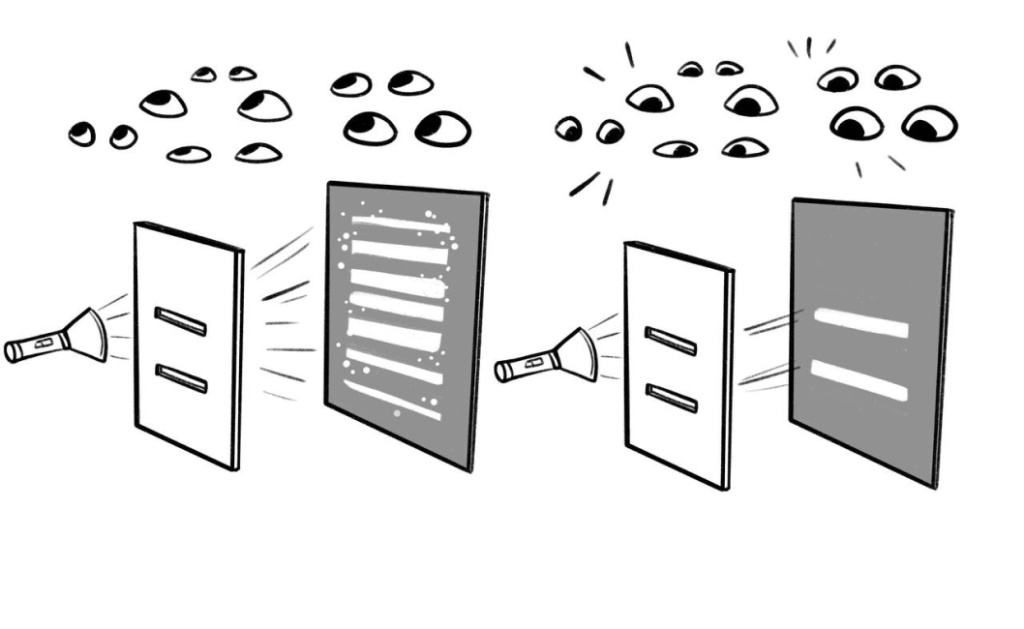
– Some kind of mysticism,’ other scientists whispered. ‘Magic, Witchcraft. We clearly saw a pattern of 2 stripes on the wall, but when we stopped looking, the pattern changed. He’s fooling us! Turn on the light!
While the audience, squinting, were coming to their senses, Einstein pulled Thomas Jung by his sleeve:
– You surprised us, Mister Jung. What’s your secret?
– There is no secret, Mister Einstein,’ the scientist answered with a smile.
I have done this experiment many times, trying to figure out why rays of light, or as physicists call them – photons, begin to behave like this. They jump, gather in flocks, violate all known laws, but as soon as you begin to observe this process or install an observation device, photons begin to behave like law-abiding citizens. Give it a try.
Mr. Jung handed the flashlight to Einstein. Einstein turned it over in his hands thoughtfully, checked for batteries, and even let the cat smell it. Then he said, just as thoughtfully:
– I wonder… What do old ladies do in our absence? Before your experiments, I was sure that when old women get together, they drink tea, embroider, or peacefully play poker. But now I’m not at all sure.
Perhaps they do all this when they are being watched, but when they stop watching, the old women begin to behave the same way as these photons, not wanting to reveal their secrets to us… Interesting…
– It’s something completely different that’s interesting!’ shouted the young man with a strong Bavarian accent and quickly headed towards the demonstration table. ’I will now demonstrate to you an unknown force that will make your old ladies fly up!
In his hands he had a round metal plate and a magnet.
– Look, gentlemen scientists. Each of you knows about the properties of a magnet and that it attracts objects. But what will happen if…’ the young man put a magnet on a metal plate. ‘What will happen if we cool this magnet?
And the young man quickly began to walk around the table with objects. He took out a Dewar flask with liquid nitrogen and began methodically directing a stream of cold air from the tube to the magnet.
– What happens if we cool the magnet?
The magnet instantly bounced off the plate and hung in the air. Incredible!
The audience applauded in unison. If the invisible old women from Einstein’s fantasies had been sitting on the magnet, they would have instantly flown into the air.
– Bravo, bravo, Mr. Meissner, Einstein said contentedly, bringing the cat to the magnet hanging in the air.
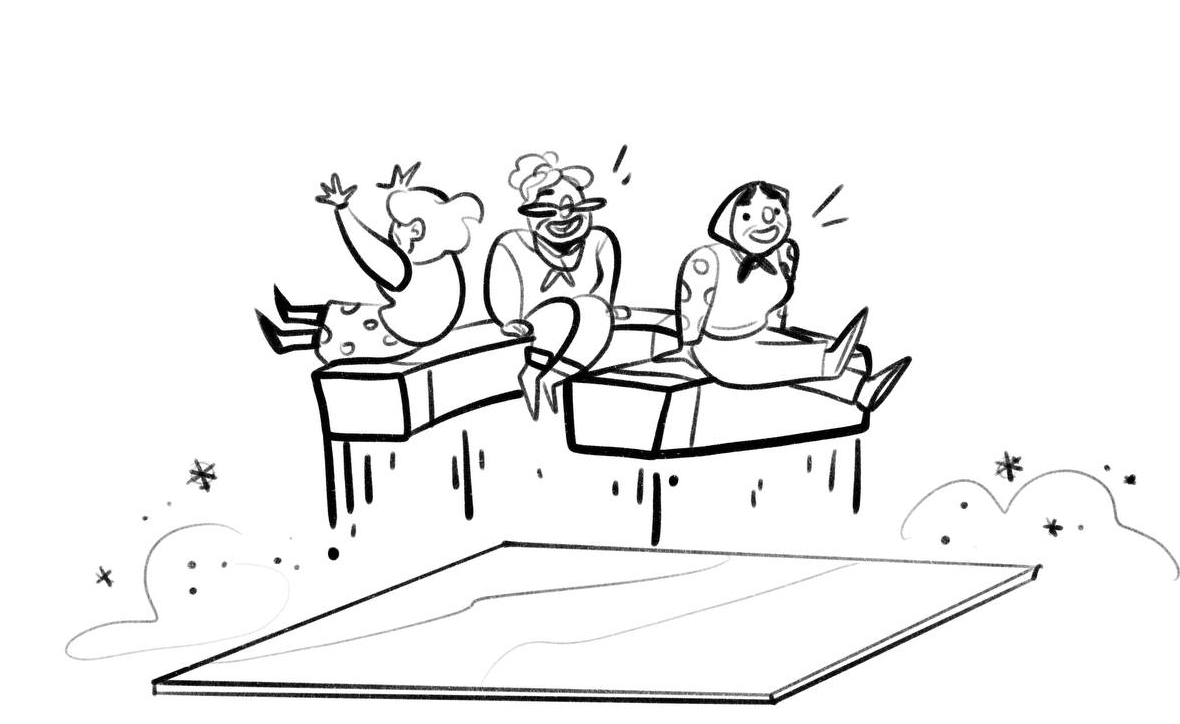
– Bravo, Mr. Meissner,’ said a tall man with carefully styled hair. “Peter Kapitsa” was written on his badge. ‘However, it’s not just magnets that can be cooled.
The man quickly walked to the table, untying a balloon inflated with helium.
– Dear viewers, there is a bowl of helium in front of you,’ he said and raised the bowl up to demonstrate it to the scientists. ‘Now, using the same liquid nitrogen, I will cool the helium to a critically low temperature. Can everyone see it?
The scientists came closer so as not to miss anything.
– Ready!
Kapitsa informed the audience. ‘Helium is now below 270 degrees Celsius. Now look, how is helium behaving?’
The spectators looked at the bowl in shock. Helium began to rise, fall, leave the bowl along the walls and return to the vessel again.
– I can’t believe my eyes!’ Einstein exclaimed.
– And this is very rare, because the only thing I believe in is Newton’s apples and eyeballs.
– Helium atoms belong to the class of bosons, said Mr. Schrödinger, who had been silent until this moment.
– This means that an unlimited number of such particles can be in the same quantum state. That means that the cat is both alive and dead. Can I see you for a minute?
Schrödinger took Pyotr Kapitsa by the elbow and began to tell him something in his ear. Pyotr Kapitsa listened to him attentively and sometimes looked at the cat with interest. At that moment, did Peter Kapitsa realize that several years would pass and almost all MRI tomographs would use superconducting magnets? And did he realize that all physics textbooks would depict the same boson with spin-momentum?
Did all the scientists present at that moment realize that the superposition effect and the observer effect would lay the basis for a new way of encrypting data, and the uncertainty principle would play a decisive role in the formation of quantum science? We do not know.
But we definitely know that you can’t hold the world of science, just like the world of imagination, by force. You can only hold it by understanding.
As a sign of agreement in one of the parallel Universes, Einstein nodded and stuck out his tongue.
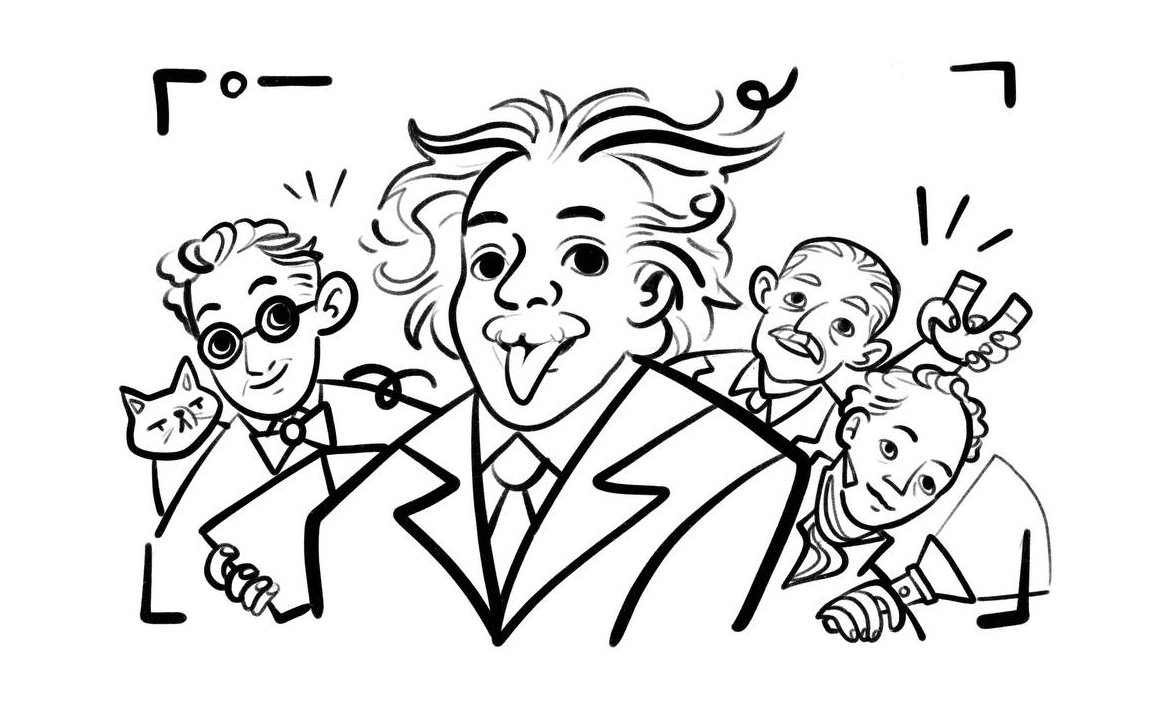
We’ve discovered new laws of the Universe in your pocket. By the way, there are many forgotten things in the Universe too.
Thank you!


